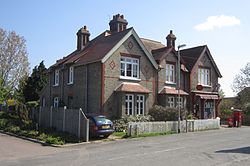Stow cum Quy: Difference between revisions
Created page with '{{Infobox town |name=Stow cum Quy |county=Cambridgeshire |picture=Stow cum Quy village centre.JPG |picture caption=Stow cum Quy village centre |os grid ref=TL520606 |latitude=52…' |
m moved Stowe cum Quy to Stow cum Quy |
(No difference)
| |
Revision as of 23:31, 12 February 2014
| Stow cum Quy | |
| Cambridgeshire | |
|---|---|
 Stow cum Quy village centre | |
| Location | |
| Grid reference: | TL520606 |
| Location: | 52°13’23"N, -0°13’31"E |
| Data | |
| Population: | 426 (2001) |
| Post town: | Cambridge |
| Postcode: | CB25 |
| Dialling code: | 01223 |
| Local Government | |
| Council: | South Cambridgeshire |
| Parliamentary constituency: |
South Cambridgeshire |
Stow cum Quy (stoʊ kəm kwaɪ), commonly referred to as Quy, is a joint village and parish in Cambridgeshire, around 4 miles northeast of Cambridge. It is to be found between the Burwell Road (B1102) and the mediæval Cambridge to Newmarket road (the B1303), stretching from Quy Mill on the River Cam at A14 junction and up the lane towards Anglesey Abbey. The parish covers an area of 1,888 acres.
The village's name derives from the joining together of two settlements, one called Stow, meaning simply "place", that was around the present location of Quy church, and Quy coming from Cowey or "Cow Island", the area around the Swan pub. The parish was known as "Stow with Quy" or in Church Latin "Stow cum Quy", hence the current name.
The village is just off the A14 via the Quy interchange and is about two miles from the Newmarket Road Park and Ride. There is a bus service running between Cambridge and Newmarket passing through the neighbouring villages of Bottisham, Lode and Burwell. Nearby are a number of places of interest including the National Trust property of Anglesey Abbey and Quy Fen, a 'Site of Special Scientific Interest'. Another nearby conservation area is Wilbraham Fen and there are several picturesque walks around the village. Cycle access is good thanks to a number of cycle paths.
History
The area has been occupied for millennia and Bronze Age remains have been found in the parish. A Roman villa has been found just to the west of Quy Hall.[1]
The Anglo-Saxon Fleam Dyke runs close by the village. The two Saxon settlements of Stow and Quy built up on a raised area at the southern edge of the Great Fen that ran north all the way to Lincolnshire. The settlements were already joined by 1066, though had separate manors, and became a single ecclesiastical parish by the early 13th century. Stow was the area around the present parish church, and Quy around The Swan public house.[2]
The parish was referred to as "Stowe Quye" in mediæval times;[3]
Jeremy Collier (1650-1727), the bishop and theatre critic, was born in the village and has a street named after him.[2]
The oldest parts of the parish church of St Mary at Stow End date from the 12th century. The nave and chancel were built around 1340.[2] A Wesleyan chapel was built in 1840 but closed just after the Second World War and was demolished when the Wheatsheaf pub was extended.[1]
Village life

Quy currently supports three public houses. The White Swan, or Swan, a timber-framed house, was open by 1750. The Prince Albert opened in the 1840s on the Newmarket Road and was renamed The Missing Sock after refurbishment in 2010. The Wheatsheaf at Stow End opened in the late 19th century. Former pubs in the village were The Plough which opened in the late 18th century and was perhaps replaced by The Bush which was open from 1821 to 1904.[2]
The village sign was erected to commemorate the Silver Jubilee of Elizabeth II.
Outside links
| ("Wikimedia Commons" has material about Stow cum Quy) |
References
- ↑ 1.0 1.1 Stow cum Quy: History
- ↑ 2.0 2.1 2.2 2.3 A History of the County of Cambridge and the Isle of Ely Volume 10
- ↑ Plea Rolls of the Court of Common Pleas; National Archives; CP 40/717; http://aalt.law.uh.edu/AALT1/H6/CP40no717/bCP40no717dorses/IMG_1562.htm; last entry, mentioning John Ansty, gentleman
